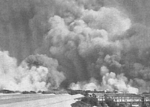Cross Island, Mumbai

Cross Island, locally known as Chinal Tekdi, is an uninhabited or sparsely inhabited island located in Mumbai harbour, India, between the coast at Dockyard Road, and Elephanta Island, about 400 m from Ferry Wharf on the east coast of Mumbai. The island is host to an oil refinery and several large gas holders, and features the ruins of a fort. The fort occupies almost the entire island, and was perhaps built by the Portuguese or the British settlers. There are several cannons strewn across the fort, and one very large gun. The top of the fort has a mound with a solitary large Ficus (Peepal) tree. The island is sparsely occupied by fisher folk, although it seems to have no natural source of fresh water. At the base of the fort, some brick and mortar construction lies in dilapidated condition. This is obviously more recent as compared to the fort and seems to have been deserted by the occupants for unknown reasons. While there is no guided tour or regular transport available to reach the island, it is possible to get such a service from local fishermen around ferry wharf for about Rs. 1000 for a 6-seater boat.
Excerpt from the Wikipedia article Cross Island, Mumbai (License: CC BY-SA 3.0, Authors, Images).Cross Island, Mumbai
Angriya Water Terminal, Mumbai Wadi Bandar (Zone 1)
Geographical coordinates (GPS) Address Nearby Places Show on map
Geographical coordinates (GPS)
| Latitude | Longitude |
|---|---|
| N 18.95 ° | E 72.85 ° |
Address
Angriya Water Terminal
Angriya Water Terminal
400001 Mumbai, Wadi Bandar (Zone 1)
Maharashtra, India
Open on Google Maps








